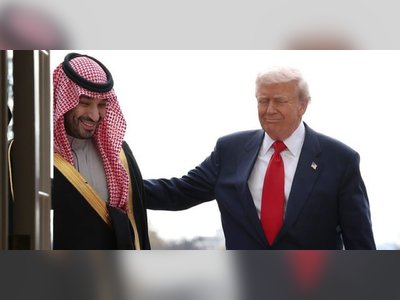
What Critics Don’t Understand About NFTs
The complexity and arbitrariness of non-fungible tokens are a big part of their appeal.
Long before cryptocurrency speculators got involved, art prices were capricious—as the British artist Banksy no doubt understands. Recently, the work “Game Changer,” which he delivered unsolicited to an English hospital last year, earned it $23.2 million at auction—about $20 million more than experts had predicted. Banksy has famously mocked high-priced sales: In 2006’s “Morons,” he portrays an auction house selling a work that reads I can’t believe you morons actually buy this shit.
Last month a company called Injective Protocol took the spirit of “Morons” to a new extreme: After purchasing one of 500 prints of that work for just under $100,000, the company scanned the print and then destroyed it. A copy of the resulting digital file was then placed on IPFS—a distributed data-storage network whose initials stand for interplanetary file system—for anyone to see. A “non-fungible token,” or NFT, that points to the work was exchanged for almost 230 units of a cryptocurrency called Ether, about $400,000. All things considered, the purchaser of that token might have been in on the joke rather than the butt of it: Some NFTs are selling for tens of millions of dollars.
These high prices suggest that regulators may not be moving quickly enough to protect unsuspecting investors. Impulsively buying GameStop shares on Robinhood is risky enough—the equivalent of placing a long-shot Kentucky Derby bet because the horse had a cool name. Worse still is losing your money because you didn’t understand what a horse race was and thought your wager was actually buying a horse.
Yet the presumption that NFT buyers are being ripped off misses an important paradox of certain digital goods: The less of a link they have to tangible, non-internet stores of value, the higher the price they might command. NFTs’ abstraction, their seemingly arbitrary valuation, and even the paltriness of the privileges they convey to their owners are, for now, big selling points, especially to buyers purchasing directly from artists. People have complex reasons for buying things, and NFTs are no exception.
In the long history of technology and finance, new and complicated phenomena have frequently led to large sums of money rapidly changing hands. In fact, many markets depend on this dynamic, especially in arcane realms even more disconnected from real-world referents than NFTs are. During the 2008 financial crisis, another three-letter acronym—CDOs, for collateralized debt obligations—collapsed as curiously as they came about, giving rise to the 2008 financial crisis. The complexity that makes them so sketchy in the eyes of regulators and financial commentators appealed to certain investors.
Some artists and other content creators have described the NFT craze as a blessing. They’re selling comic books, music albums, digital artwork, tweets, basketball videos, and even farts, in many cases for large sums of money, on a “blockchain,” a collectively generated, public, distributed ledger that undergirds cryptocurrencies such as bitcoin and Ethereum. Some artists, such as the Canadian DJ deadmau5, are cashing in even as they declare skepticism. After acknowledging that he’d made a “low effort NFT,” deadmau5 told his Instagram followers that “artists are happy to have finally found a way to fuck people over harder than any major label ever could.”
In the narrowest version of an NFT, its first buyer is getting three things: the warm feeling that may accompany financing an artist; the pride that comes with claiming a relationship to a digital artifact and its creator; and perhaps most tangibly, an asset that can be traded at a later date. The buyer is not, however, acquiring anything that they alone can use. In the physical world, if you purchase a candy bar, you can’t give someone a piece of it without losing a few bites of your own. That makes your freedom to take a bite valuable, because the bar has only so much chocolate.
By contrast, an NFT buyer is not purchasing a work, but rather a publicly available token that links to a work. For example, for a digital picture, the token may be a unique number and a link to a copy of the picture, hosted on a service such as IPFS. The token itself is visible to all, as is the work to which it points, so anyone else can look at the work and download it. And most NFT transactions don’t purport to convey copyright or other intellectual-property interests regarding the work in question, so owning an NFT tied to an animation of, say, a flying Pop-Tart cat doesn’t put you in a position to use that animation any differently than someone who hadn’t bought it. You have only a token that is hosted publicly online, “registered” as assigned to your digital wallet rather than someone else’s. If you orchestrate your wallet through an app, the app might present you with a handsome visual trophy case listing the NFTs that you’ve purchased. (As you can see, we’re having to reach to describe unique value.)
By these terms, many NFT purchases are akin to acquiring a piece of art that nevertheless remains in the gallery where it was sold, open all the time to members of the public, who may grab a free print of the work after their visit—a replica so perfect that it can be considered an original for many purposes. Moreover, the museum might not happen to take care of “your” piece of art: It could lose it, damage it, replace it, or destroy it. Indeed, enough linked NFT assets have failed to load that a website, checkmynft.com, has been auditing some of the items sold on major platforms and hosted on IPFS.
To be sure, purchasing an NFT can come with extras, such as a tchotchke mailed to the buyer. You may wonder whether reselling the NFTs requires mailing that tchotchke to the next buyer. Maybe. In one instance, a $500,000 NFT for a digital “house” included a set of plans transferred to the buyer that the buyer could use exclusively—on the promise that if they sold the token, they’d pass along the plans and then delete their own copy.
But these more conventional fragments of ownership—ancillary artifacts or services that could be sold on eBay or at a flea market—are distractions from the value of NFTs more than enhancements of it. An essential part of NFTs’ value is that they don’t convey anything resembling traditional ownership.
When patrons support artists with a grant—and perhaps receive a public thanks from the artist—they are not buying works, but rather publicly signaling their commitment to the artist, intertwining their respective reputations. They are conspicuously consuming vapors, and the very intangibility of the benefits contributes to the conspicuousness. One is reminded of the short-lived app called I Am Rich, which merely displayed an image of a glowing red gem. It ran for $999.99 in the Apple App Store, and scored eight purchasers, only two of whom appeared to regret their purchase enough to seek a refund. And apps can’t be resold—so those purchasers weren’t in it for any perceived investment value.
At this point, no one should be surprised that NFTs can gain such high valuations based on so little. They are, after all, traded via cryptocurrency blockchains whose core function is to record the sale of unique internet tokens that need not point to anything at all and yet are independently accorded value because they’re commonly understood to be currency. When the cryptocurrency Ether—whose name is literally a synonym for vapor!—is going for $2,100 a unit, why should an Ethereum NFT that points to a digital artwork not also accrue independent attention? A single unit of bitcoin that fetched $4 when one of us first taught a class about it in 2011 is worth thousands of dollars today. Some “crypto whales”—people who got rich from that appreciation—have a near-religious commitment to cryptocurrency and its derivative technologies, and choose to keep their wealth on the blockchain beyond the usual standards of economic rationality.
Whether fungible or not, or currency or not, the value of blockchain tokens has arisen through a paradox. If Comcast, Walmart, or Goldman Sachs tried to build and operate a centralized blockchain, owning all the tokenized “coins” at first, few people would turn up to buy them and expect them to carry value—at least if the companies were offering no independent benefit in exchange. But bitcoin and its siblings are different in that no one in particular owns or operates them. Rather, unaccredited possessors of computing power have subscribed to the published protocols that describe blockchains, and have chosen to breathe life into them by lending their computing power to documenting the transactions there—in exchange for bits of that cryptocurrency. The paradox is that such currencies, when they work, have value precisely because no one formally controls them.
The internet itself similarly functions as a collective hallucination, owned by no one. It has no CEO. No entity controls its evolution. There are only manufacturers of internet devices, operators of networks that interconnect with the larger network, and authors of software that “speak” internet. When new internet standards are proposed by the unincorporated volunteer organization that stewards those protocols, they are not adopted through regulatory mandate, but through emergent consensus that they are better than what came before—or at least that they are likely to be adopted by others, who in turn are looking to see what everyone else is doing. This might seem like a shaky foundation for creative and commercial activities—one far more precarious than what the implacable mechanisms of centralized authorities would provide—but companies with trillion-dollar market capitalizations and a whole way of life have been built upon it. Had AOL or CompuServe or some other self-interested incumbent proposed to run a global interoperable computer network whose value depended upon contributions from others, it never would have taken off.
While the NFT party is going, one can hardly begrudge people who turn up as buyers and sellers, so long as they know what’s actually being exchanged and realize that they might be the last ones holding the tulip—or the token for a now-destroyed Banksy print.
The NFT craze, and the blockchains underlying it, lay bare the philosophical questions around why we treasure things beyond any tangible worth to us—and the leap of faith we indulge, wisely or otherwise, when we buy something not because of any innate worth to us but because we expect others to value it later. That its worth can arise through collective action is a testament to the unpredictability of human events—and a reminder that not everything in life gains value from top-down fiat.
Last month a company called Injective Protocol took the spirit of “Morons” to a new extreme: After purchasing one of 500 prints of that work for just under $100,000, the company scanned the print and then destroyed it. A copy of the resulting digital file was then placed on IPFS—a distributed data-storage network whose initials stand for interplanetary file system—for anyone to see. A “non-fungible token,” or NFT, that points to the work was exchanged for almost 230 units of a cryptocurrency called Ether, about $400,000. All things considered, the purchaser of that token might have been in on the joke rather than the butt of it: Some NFTs are selling for tens of millions of dollars.
These high prices suggest that regulators may not be moving quickly enough to protect unsuspecting investors. Impulsively buying GameStop shares on Robinhood is risky enough—the equivalent of placing a long-shot Kentucky Derby bet because the horse had a cool name. Worse still is losing your money because you didn’t understand what a horse race was and thought your wager was actually buying a horse.
Yet the presumption that NFT buyers are being ripped off misses an important paradox of certain digital goods: The less of a link they have to tangible, non-internet stores of value, the higher the price they might command. NFTs’ abstraction, their seemingly arbitrary valuation, and even the paltriness of the privileges they convey to their owners are, for now, big selling points, especially to buyers purchasing directly from artists. People have complex reasons for buying things, and NFTs are no exception.
In the long history of technology and finance, new and complicated phenomena have frequently led to large sums of money rapidly changing hands. In fact, many markets depend on this dynamic, especially in arcane realms even more disconnected from real-world referents than NFTs are. During the 2008 financial crisis, another three-letter acronym—CDOs, for collateralized debt obligations—collapsed as curiously as they came about, giving rise to the 2008 financial crisis. The complexity that makes them so sketchy in the eyes of regulators and financial commentators appealed to certain investors.
Some artists and other content creators have described the NFT craze as a blessing. They’re selling comic books, music albums, digital artwork, tweets, basketball videos, and even farts, in many cases for large sums of money, on a “blockchain,” a collectively generated, public, distributed ledger that undergirds cryptocurrencies such as bitcoin and Ethereum. Some artists, such as the Canadian DJ deadmau5, are cashing in even as they declare skepticism. After acknowledging that he’d made a “low effort NFT,” deadmau5 told his Instagram followers that “artists are happy to have finally found a way to fuck people over harder than any major label ever could.”
In the narrowest version of an NFT, its first buyer is getting three things: the warm feeling that may accompany financing an artist; the pride that comes with claiming a relationship to a digital artifact and its creator; and perhaps most tangibly, an asset that can be traded at a later date. The buyer is not, however, acquiring anything that they alone can use. In the physical world, if you purchase a candy bar, you can’t give someone a piece of it without losing a few bites of your own. That makes your freedom to take a bite valuable, because the bar has only so much chocolate.
By contrast, an NFT buyer is not purchasing a work, but rather a publicly available token that links to a work. For example, for a digital picture, the token may be a unique number and a link to a copy of the picture, hosted on a service such as IPFS. The token itself is visible to all, as is the work to which it points, so anyone else can look at the work and download it. And most NFT transactions don’t purport to convey copyright or other intellectual-property interests regarding the work in question, so owning an NFT tied to an animation of, say, a flying Pop-Tart cat doesn’t put you in a position to use that animation any differently than someone who hadn’t bought it. You have only a token that is hosted publicly online, “registered” as assigned to your digital wallet rather than someone else’s. If you orchestrate your wallet through an app, the app might present you with a handsome visual trophy case listing the NFTs that you’ve purchased. (As you can see, we’re having to reach to describe unique value.)
By these terms, many NFT purchases are akin to acquiring a piece of art that nevertheless remains in the gallery where it was sold, open all the time to members of the public, who may grab a free print of the work after their visit—a replica so perfect that it can be considered an original for many purposes. Moreover, the museum might not happen to take care of “your” piece of art: It could lose it, damage it, replace it, or destroy it. Indeed, enough linked NFT assets have failed to load that a website, checkmynft.com, has been auditing some of the items sold on major platforms and hosted on IPFS.
To be sure, purchasing an NFT can come with extras, such as a tchotchke mailed to the buyer. You may wonder whether reselling the NFTs requires mailing that tchotchke to the next buyer. Maybe. In one instance, a $500,000 NFT for a digital “house” included a set of plans transferred to the buyer that the buyer could use exclusively—on the promise that if they sold the token, they’d pass along the plans and then delete their own copy.
But these more conventional fragments of ownership—ancillary artifacts or services that could be sold on eBay or at a flea market—are distractions from the value of NFTs more than enhancements of it. An essential part of NFTs’ value is that they don’t convey anything resembling traditional ownership.
When patrons support artists with a grant—and perhaps receive a public thanks from the artist—they are not buying works, but rather publicly signaling their commitment to the artist, intertwining their respective reputations. They are conspicuously consuming vapors, and the very intangibility of the benefits contributes to the conspicuousness. One is reminded of the short-lived app called I Am Rich, which merely displayed an image of a glowing red gem. It ran for $999.99 in the Apple App Store, and scored eight purchasers, only two of whom appeared to regret their purchase enough to seek a refund. And apps can’t be resold—so those purchasers weren’t in it for any perceived investment value.
At this point, no one should be surprised that NFTs can gain such high valuations based on so little. They are, after all, traded via cryptocurrency blockchains whose core function is to record the sale of unique internet tokens that need not point to anything at all and yet are independently accorded value because they’re commonly understood to be currency. When the cryptocurrency Ether—whose name is literally a synonym for vapor!—is going for $2,100 a unit, why should an Ethereum NFT that points to a digital artwork not also accrue independent attention? A single unit of bitcoin that fetched $4 when one of us first taught a class about it in 2011 is worth thousands of dollars today. Some “crypto whales”—people who got rich from that appreciation—have a near-religious commitment to cryptocurrency and its derivative technologies, and choose to keep their wealth on the blockchain beyond the usual standards of economic rationality.
Whether fungible or not, or currency or not, the value of blockchain tokens has arisen through a paradox. If Comcast, Walmart, or Goldman Sachs tried to build and operate a centralized blockchain, owning all the tokenized “coins” at first, few people would turn up to buy them and expect them to carry value—at least if the companies were offering no independent benefit in exchange. But bitcoin and its siblings are different in that no one in particular owns or operates them. Rather, unaccredited possessors of computing power have subscribed to the published protocols that describe blockchains, and have chosen to breathe life into them by lending their computing power to documenting the transactions there—in exchange for bits of that cryptocurrency. The paradox is that such currencies, when they work, have value precisely because no one formally controls them.
The internet itself similarly functions as a collective hallucination, owned by no one. It has no CEO. No entity controls its evolution. There are only manufacturers of internet devices, operators of networks that interconnect with the larger network, and authors of software that “speak” internet. When new internet standards are proposed by the unincorporated volunteer organization that stewards those protocols, they are not adopted through regulatory mandate, but through emergent consensus that they are better than what came before—or at least that they are likely to be adopted by others, who in turn are looking to see what everyone else is doing. This might seem like a shaky foundation for creative and commercial activities—one far more precarious than what the implacable mechanisms of centralized authorities would provide—but companies with trillion-dollar market capitalizations and a whole way of life have been built upon it. Had AOL or CompuServe or some other self-interested incumbent proposed to run a global interoperable computer network whose value depended upon contributions from others, it never would have taken off.
While the NFT party is going, one can hardly begrudge people who turn up as buyers and sellers, so long as they know what’s actually being exchanged and realize that they might be the last ones holding the tulip—or the token for a now-destroyed Banksy print.
The NFT craze, and the blockchains underlying it, lay bare the philosophical questions around why we treasure things beyond any tangible worth to us—and the leap of faith we indulge, wisely or otherwise, when we buy something not because of any innate worth to us but because we expect others to value it later. That its worth can arise through collective action is a testament to the unpredictability of human events—and a reminder that not everything in life gains value from top-down fiat.











